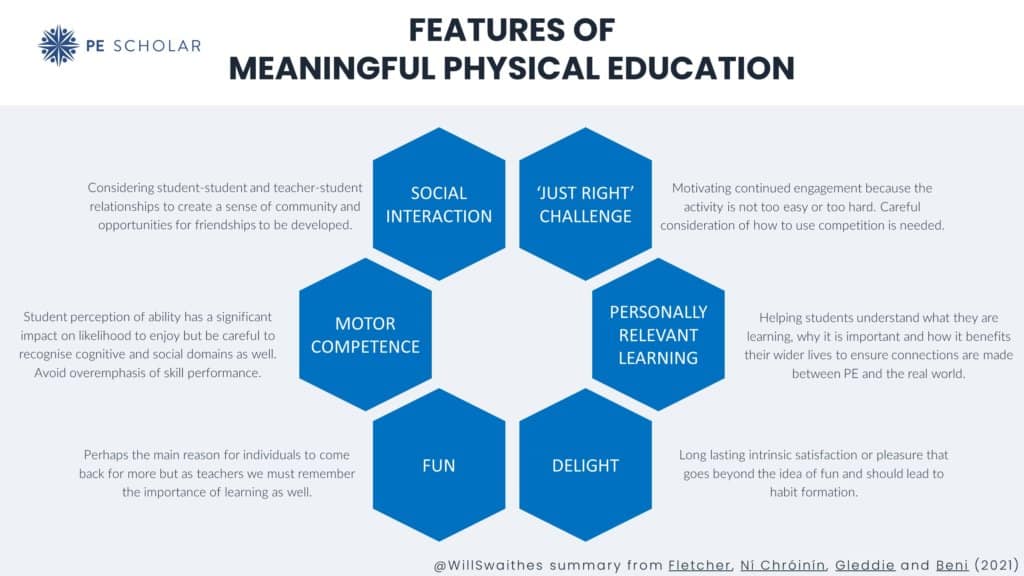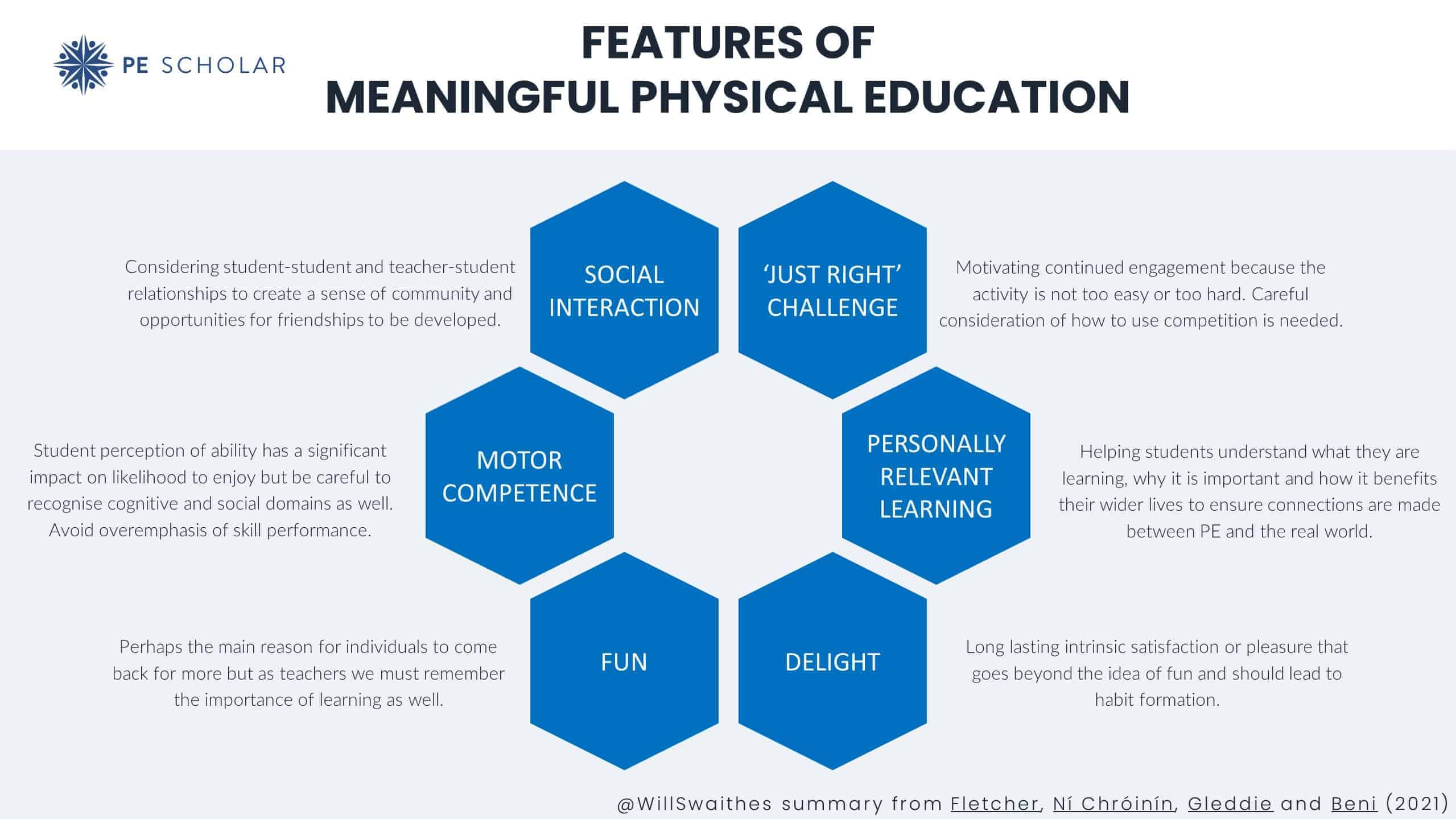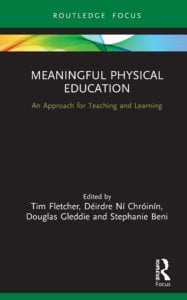
I am pleased to say that engagement with the idea of ‘Meaningful Physical Education’ (MPE) has really ramped up in the last few years. Whilst the idea dates back at least 50 years, Tim Fletcher, Déirdre Ní Chróinín, Doug Gleddie and Steph Beni have done a great job of popularising and bringing to life both the why and the how of MPE. This book will help you consider the importance of ‘movement as a primary way to enrich the quality of young people’s lives, shifting the focus of physical education programs to better suit the needs of contemporary young learners and resist the utilitarian health-orientated views of physical education that currently predominate in many schools and policy documents.’ (p2)
The book is divided into 4 parts, I will briefly explore each of them below.
Part 1 – Introducing Meaningful Physical Education
Quick to explain this is not a step-by-step guide but more a ‘filter for pedagogical decisions and actions’ (p4), Fletcher and colleagues argue the case for helping all individuals find meaning in movement and consequently increased likelihood of ongoing engagement with sport, physical activity and movement (SPAM). ‘The primary theme of Meaningful PE is to support students in coming to value physical education through experiencing meaningfulness (i.e., interpreting an experience as having personal significance) and recognising ways participation enhances the quality of their lives’ (p4). That may sound obvious, but I think we can all agree that it is an ambition that is not currently being met in all schools and for all students. It is not easy, especially with class sizes of 30+ and limitations in terms of time, space, facilities, equipment etc but that is not to say it shouldn’t be our duty as custodians of the subject. For every negative experience in PE there is a significant risk of individuals choosing to avoid future opportunities. To achieve MPE requires careful consideration of a complex mis of cognitive, affective, social, cultural and relational dimensions.
Following a major literature review drawing on the work of Kretchmar (2006) and some 50 peer-reviewed studies, Fletcher et al. propose the following 6 features of MPE:

Beyond these features, the pursuit of MPE requires us to be democratic and reflective. Engaging staff and students in the co-construction of a curriculum results in ownership and an increased sense of value. It must be inclusive, promoting ‘voice and choice’ to enable student needs, motivations and preferences to be considered. Helping staff and students to reflect on and set goals for future engagement helps promote a shared language, understanding and value of MPE.
Part 2 – Meaningful Physical Education by teachers
Andy Vasily explores the significant role sport, physical activity and movement (SPAM) has played in shaping his identity. He unpicks ‘how the feature of challenge could not only be prioritised but also unpacked with [my] students at a deeper level’ (p44). Andy shares some important reflective questions that have helped him consider and refine his PE program before describing a specific cycling unit that he designed to ensure challenge for all. A self-assessment scale of ‘Easy Peasy Lemon Squeezy’ to ‘Just Right Challenge’ and on through to ‘Impossible at this Point’ helped students explore and learn at their own pace. He goes on to unpick other features of MPE through a skateboarding and a racquet sports unit.
Milena Trojanovic shares how she now focuses more on those who have not yet fallen in love with physical activity and shares her successes with a focus on positive social interactions. This movement away from an early career philosophy around traditional sports and fitness testing aims to ‘meet the needs of all learners’ (p57). Milena explains how she adapted a gymnastics unit to ensure personal relevance and other features of MPE. I love the examples of student responses to key questions like ‘how can building confidence using your body in different ways influence how you participate in physical activities in the future?’ (p40) as a part of this unit to promote self-reflection and connection with a unit that many students struggle to value in my experience.
Steph Beni then reflects on her own efforts to ensure MPE over 5 years as a teacher and researcher. She shares the importance of ongoing professional development to stay current but also to invite critique by colleagues to help reflect on and refine practice to ensure it is more meaningful and more relevant to meet the needs of more students.
Alex Beckey then shares a powerful chapter on MPE as a metaphor for teaching PE. In it he reflects on a story I have heard first hand around a critical incident of bumping into a previous student whose delight for rugby had been sucked out via a technical mastery and isolated practice driven focus. I wonder how many of us have inadvertently coached the love out of sport, physical activity or movement? Alex shares the importance of aligning ‘learning intentions/ outcomes, activities, pedagogical approaches, and assessments … with the features of Meaningful PE’ (p53). He advocates for observation and intervention through a lens of more than just motor competence and correct technique. This idea is explained clearly with several helpful worked examples of his ‘equaliser framework’ and the reflection that breaking habits as an experienced practitioner is tough. On page 81 Alex shares 4 important considerations if you want to adopt a MPE philosophy:
- ‘Observation is more important than intervention’ – invest more time in stepping back to really notice what is going on in your lessons and ensure you offer a balance of actions based on all 6 MPE features
- ‘Dialogue is an essential intervention’ – have proper conversations with your students
- ‘Do no harm with your interventions’ – watch out for and avoid anything that could cause physical, psychological or emotional harm to your students
- ‘The features are not a checklist’ – avoid siloed thinking as the features of MPE are complex and overlapping
Part 3 – Meaningful Physical Education by teacher educators
If, like me, you are involved in physical education teacher education (PETE) then you will want to consider how and when the ideas are best introduced to and explored with pre-service teachers (PST). Tim and Déirdre share data from four years’ worth of commitment to MPE within teacher education in Canada and Ireland respectively. They explore the challenges of a lack of empirical evidence and perception that this is just about ‘good teaching’ (p91). The following 5 principles are discussed in detail on pages 91-93:
- Principle 1: Teacher educators explicitly prioritise meaningful participation in the planning, teaching and assessment of PETE
- Principle 2: Teacher educators model pedagogies that support meaningful experiences
- Principle 3: Support PSTs’ engagement with features of meaningful participation as a learner and as a teacher
- Principle 4: Frame learning activities using features of meaningful participation
- Principle 5: Support reflection on meaningfulness of PE experiences
I agree that the shared language of MPE helps ensure a holistic focus on far more than a sport-driven and technique focused curricula whilst also giving flexibility to personal philosophies, ideologies and local contexts. You will also enjoy reading about how other teacher educators have brought this to life to include Doug Gleddie and Jodi Haring-Kuriger describing their why and how of implementation.
Part 4 – Moving forward with Meaningful Physical Education
This last section shares more case studies from practice to help us realise:
- the importance of student voice in curriculum/ lesson decision-making
- the value of seeing the bigger picture and celebrating learning via special events (e.g., a flash mob dance)
- how thinking differently about a cross country running unit can have a dramatic impact on inclusion, engagement, and learning
- the importance of and value in ‘social-emotional skill building’ (p128) as well as simplifying and scaffolding activities
- the importance of considering local environments and ‘personal playgrounds’ when deciding what activities should feature in your offer
- the need for a shared vision for PE across a department
- how MPE is ‘well-positioned to support – rather than act in competition with – other initiatives (e.g.g, physical literacy, teaching games for understanding, positive youth development) in PE and sport settings’ (p132)
- how Covid-19 may have accelerated the need for transformation in physical education to ensure it is more meaningful to all young people
I highly recommend this book to trainees, teachers and teacher educators alike. If you have not yet found LAMPE (Learning About Meaningful Physical Education) and the helpful blogs, presentations, research and more then I highly recommend heading over to https://meaningfulpe.wordpress.com/.
We have also released a bitesize course on Meaningful PE that is free to PE Scholar members and available here.
Here is a list of other book reviews you might want to check out:
Reviews by topic
Health and wellbeing
Happiness Factories: A success-driven approach to holistic Physical Education (podcast)
Time to RISE Up: Supporting Students’ Mental Health in Schools
Physical Education Pedagogies for Health
Inclusion and social justice
Inclusive PE for SEND Children and podcast
Teaching Disabled Children in Physical Education
Pedagogies of Social Justice in Physical Education and Youth Sport
Pedagogy
Applying Models-based Practice in Physical Education
Perspectives on Game-Based Coaching
The Future of Teaching and the Myths That Hold it Back
Threshold Concepts in Physical Education
The Spectrum of Teaching Styles in Physical Education and podcast
Reading lists
Also, don’t forget to take a look at these books published by Scholarly – indispensable additions to every PE teacher’s bookshelf.



[…] Meaningful PE […]